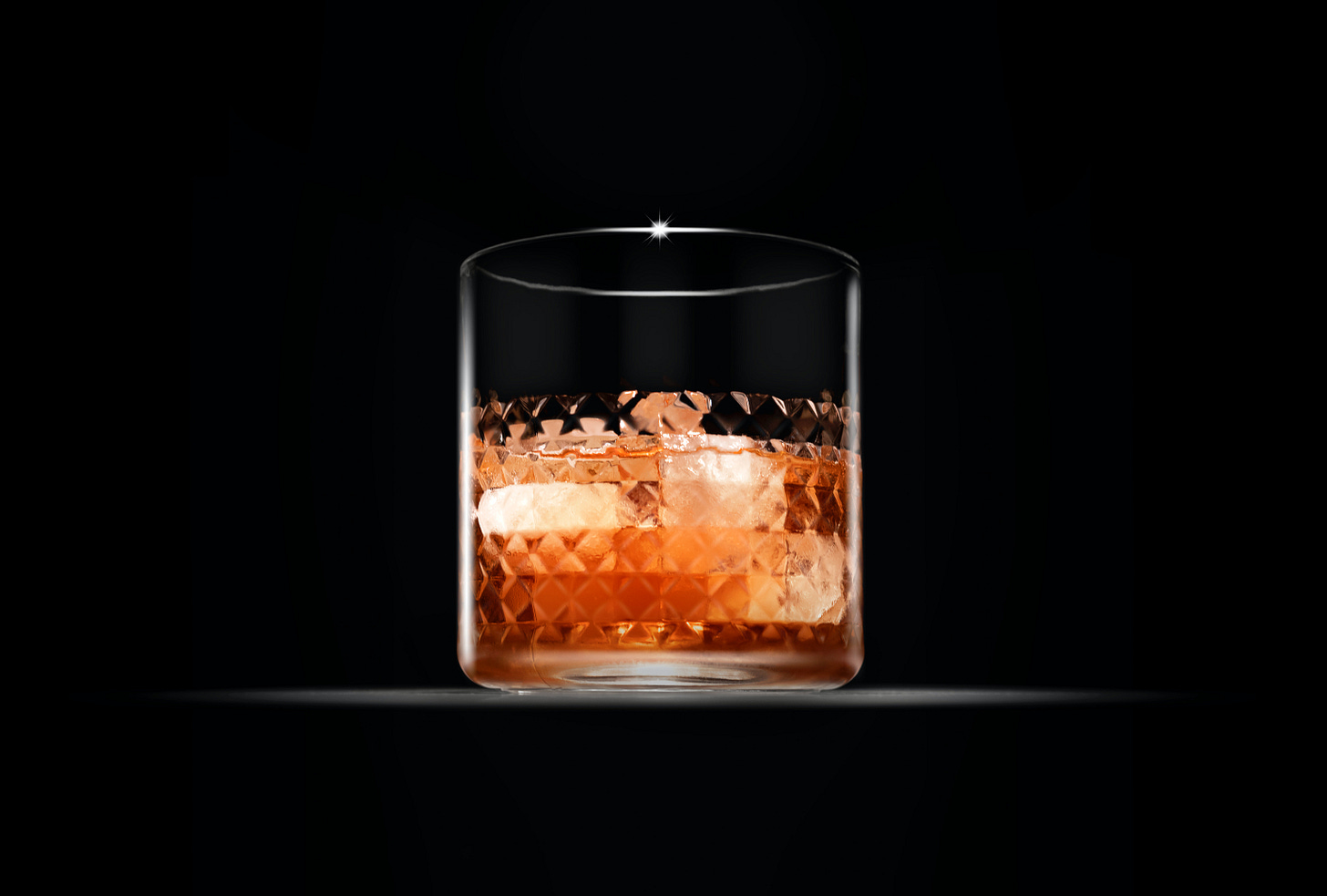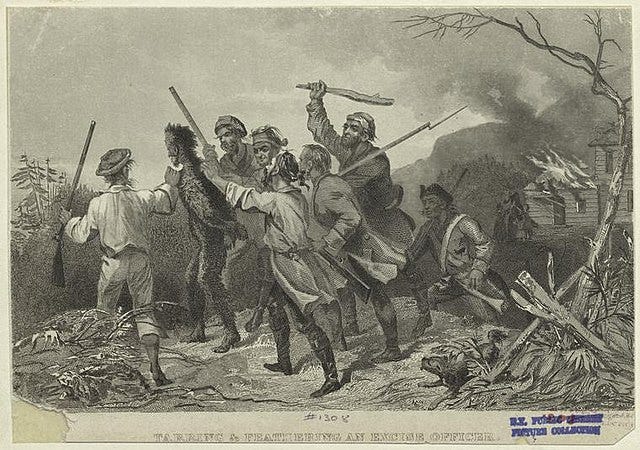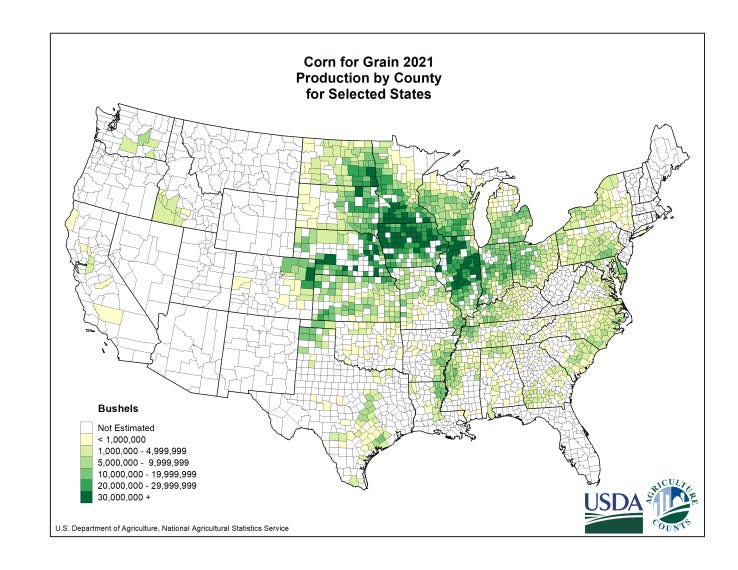
Apologies for the late newsletter! I’ve been on the road this week, and also fighting a deadline. Let me make it up to you by delving into the “nature” of the South’s favorite liquor: whiskey.
The tipple of choice in my household tends to be whiskey, and Makers Mark especially—more out of habit than any well-studied preference. And after describing the “dark, sooty crust” of fungus building up outside some Jack Daniel’s warehouses in a news roundup a few weeks back, I thought it was time to turn my attention to this beverage and its connections to the landscapes of the South.
Let’s deal with that whiskey fungus first: it’s known to scientists as Baudoinia compniacensis and named for Antonin Baudoin, the French distiller who first noted the problem in 1870s in Cognac, France. The fungus is common in any region where there’s industrial-scale alcohol production; it feeds off airborne ethanol. It’s not known to pose a danger to humans or architectural structures—though some health departments recommend wearing an N95 mask if you wind up having to powerwash your home.
Whisky fungus has been spurring lawsuits for years. And it’s pretty gross. But, unfortunately, if you’re gonna be distilling at a mass scale, then this is just a problem you’re going to have.

Now on to whiskey itself, which, per the definition in The New Encyclopedia of Southern Culture, is a “spirit distilled from fermented grain and aged in hardwood barrels.” While whiskey is generally regarded as a drink of the South, its story reveals a different kind of U.S. sectionalism: at the moment that whiskey played its most pivotal role in U.S. history, no one was thinking about north and south. What they cared about was the different sides of the mountains.
The U.S. has been a boozy nation since before the nation actually existed. During the Revolution, George Washington insisted on liquor rations for soldiers, stating that “there should always be a Sufficient Quantity of Spirits with the Army” because “in many instances, such as when they are marching in hot or Cold weather, in Camp or Wet, on fatigue or in Working Parties, it is so essential that it is not to be dispensed with.” But it was the trans-mountain west—the Ohio Valley, mostly—that became a particular hotbed of distilling.
That’s in part because this frontier was a hardscrabble place where many of the early settlers had little cash and were eking what living they could out of the land. They ate their crops, fed some to pigs and horses and cattle, and sold what they could. If anything was left, the smart choice was to distill it into liquor. Liquor is, after all, nonperishable and transportable. As historian Steven Stoll notes in his excellent book Ramp Hollow, the same horse that could carry just three or four bushels of grain could manage twenty bushels once it was rendered into a spirit. In places, whiskey doubled as a kind of currency.

When Alexander Hamilton decided he wanted to rope together the young nation into a well-organized republic, he decided that liquor was a currency that needed to be taxed. A law passed in 1791 required distillers to identify themselves with the painted words “DISTILLER OF SPIRITS” on their houses. Three days before beginning a batch, they had to signal their intentions at a central office. Casks had to be branded with serial numbers before anything could be carted off the premises. Some of these distillers had fought the British—not because they cared to forge a vast new empire, just because they wanted to be free. They’d nonetheless helped spawn an empire, which now threatened to swallow their freedom.
To many on this frontier, this new tax was a 1984-level dystopic idea. The first “excise officers” to arrive in western Pennsylvania were tarred and feathered and whipped. Distillers who cooperated found their stills destroyed.
So Hamilton marched thirteen thousand soldiers into western Pennsylvania in 1794 to subdue this brewing rebellion. He found no one to fight; the perpetrators had slipped away. Still, Hamilton’s troops roused the suspects from their homes for questioning. One died after the rebels were imprisoned for two days with no food or heat. Otherwise, everyone was exonerated or pardoned by President Washington. The whole ordeal helped bring Thomas Jefferson to power a few years later, and the new president repeal the hated Whiskey Tax.
This whiskey that prompted this fight would have been unrecognizable to us, since it was unaged—and therefore white. And in Pennsylvania, the whiskey would have been made mostly with rye, or Secale cereal, a cereal that, as Steven Stoll notes, flourishes in the kind of inhospitable corners where frontier-era squatters sometimes had to claim land:
[Rye] thrives in environment too cold, dry, acidic, sandy, or worn out for wheat. It can be planted late in the season and at higher altitudes. As a winter cover crop, it returns nitrogen to the soil when it is folded under in the spring. It requires less time and attention than wheat or corn and doesn’t attract the same plethora of diseases. Rye survives in the crevices of the agrarian world, which made it ideal for the southern mountains.
This old preference lives on today in rye whiskey, which must legally consist of at least 51% rye.
By the time of the Whiskey Rebellion, there was already a different kind of liquor coming out of Kentucky. (Indeed, the anti-tax rage was as strong there; perhaps, as cocktail historian Gary Regan suggests, Hamilton decided not to anger the Kentuckians simply because they were further west—and were likelier to their loyalties to Spain, who then controlled Louisiana.) Here, in the lower hills beyond the mountains, settlers found that “corn grew like wildfire,” as historian Seán S. McKeithan writes. “Settlers could plant it quickly, even haphazardly, and its yield was robust and bountiful.”
This bountiful hazard gives us the most popular U.S. whiskey: bourbon, which, legally, must have a mash that is at least 51% corn. Legally, bourbon can be distilled anywhere in the United States, the name is drawn from Bourbon County, Virginia—fwhich was founded in 1785, and included a large swath of what is now eastern Kentucky, where the mountains give way to rolling hills.

Kentucky today is hardly an eastern thread of the Corn Belt. So, if all it takes to make good whiskey is corn and yeast and water, why has Kentucky whiskey become such a thing? Some sources suggest that the water in Kentucky is particularly fine; the underlying karst limestone serves as a natural filter. The weather also helps: during warm summer months, the whiskey expands, penetrating the wood in the surrounding barrel; the nights are cool enough for the whiskey to contract again, pulling out the wooden flavors. (The wood of choice for a bourbon barrel is American white oak, now typically harvested in Arkansas and Missouri.) Still, I think what’s at play here is mostly our attachment to old traditions. We still want that hardscrabble pioneer association, even if the whiskey we drink was long ago commercialized, brewed in batches large enough to attract roving fungi.
What lodged this drink in Southern culture may simply be the fact that when the first farmers were cranking out whiskey, it was far easier to ship the product south to New Orleans by flatboat than to lug it east through the mountains. Whiskey, then, in all its forms, is more “western” than Southern: the Ohio and the Mississippi and all their tributaries were known to the first U.S. settlers as the “western” waters. It’s a reminder, then, that the “Deep South” was not always just south.
Know your whiskeys
These boats floating down the western rivers may have helped make the whiskeys we know today. Whereas frontier “whiskey” was unaged, today rye and bourbon both must be aged for at least two years in barrels. It seems likely that this practice was developed after farmers realized their whiskey tasted much better by the time it made it downstream. (The barrels must be charred, too, which helps extract flavors from the wood, and adds its own flavors, too—but how this fact was discovered is unclear.)
There are several other requirements, but for our purposes, it’s worth knowing that:
Bourbon, which can be distilled anywhere in the U.S., must have a mash that consists of at least 51% corn.
Rye, which also can be distilled anywhere in the U.S., must have a mash that consists of at least 51% rye, imparting a spicier flavor.
Tennessee whiskey, which I have not yet mentioned, is similar to bourbon—51% corn—but can only be distilled in Tennessee, and is passed through a special charcoal filtering system.
If you go
I haven’t yet done the Bourbon Trail myself yet, but if you want to do it in a nature-centric way, the Kentucky Distillers Association offers several recommendations for bike tours. There are also chartered boat tours available on the Kentucky River.





